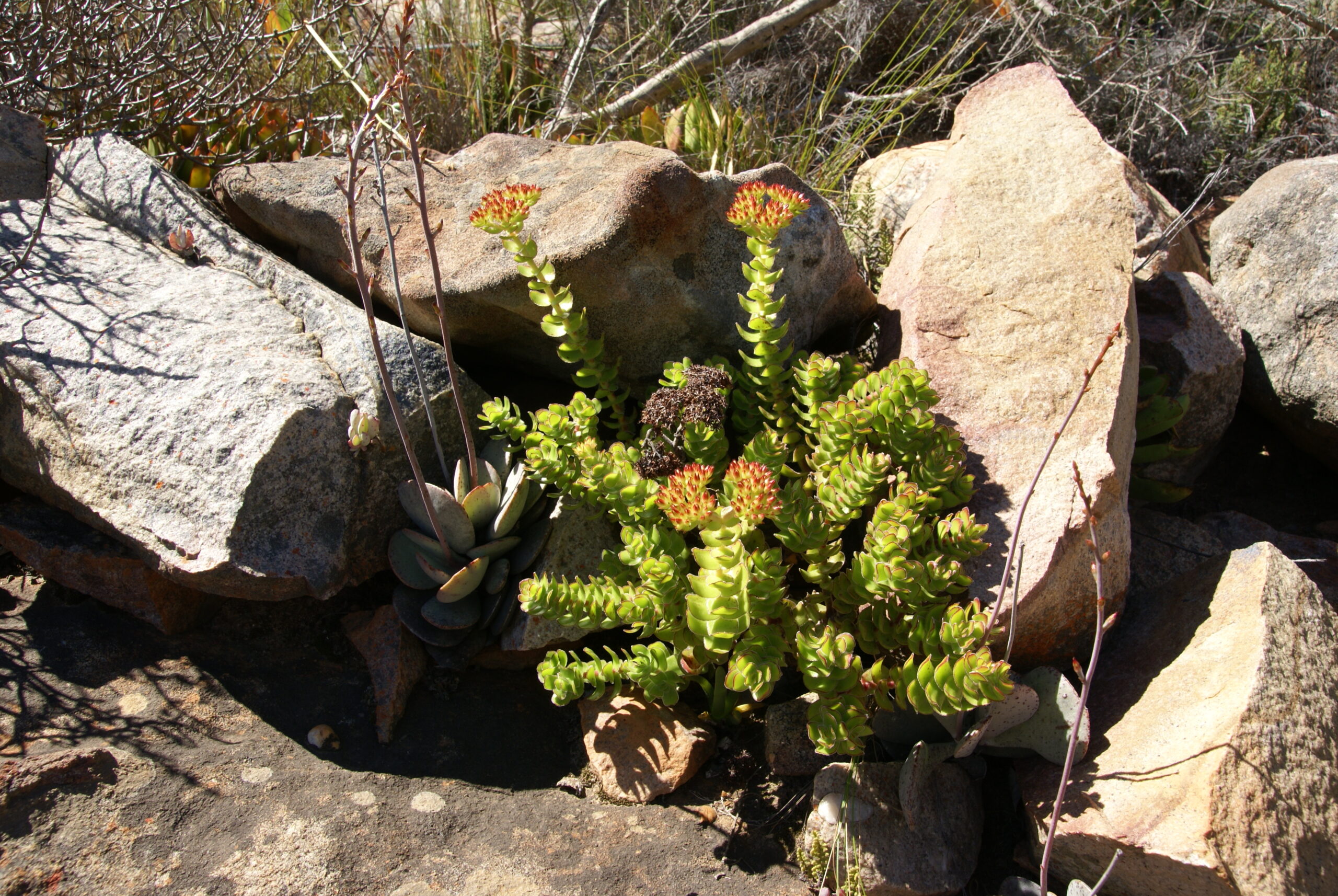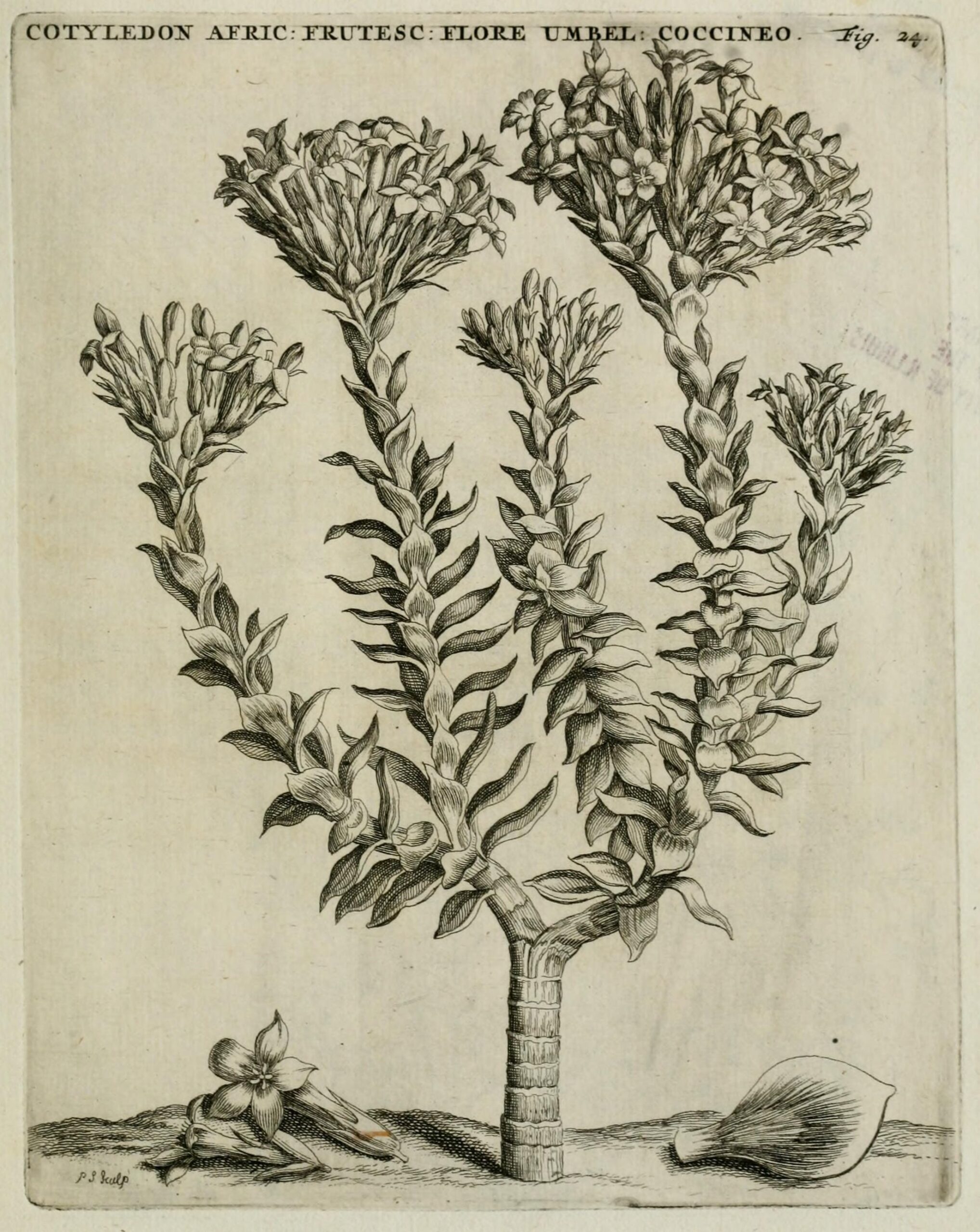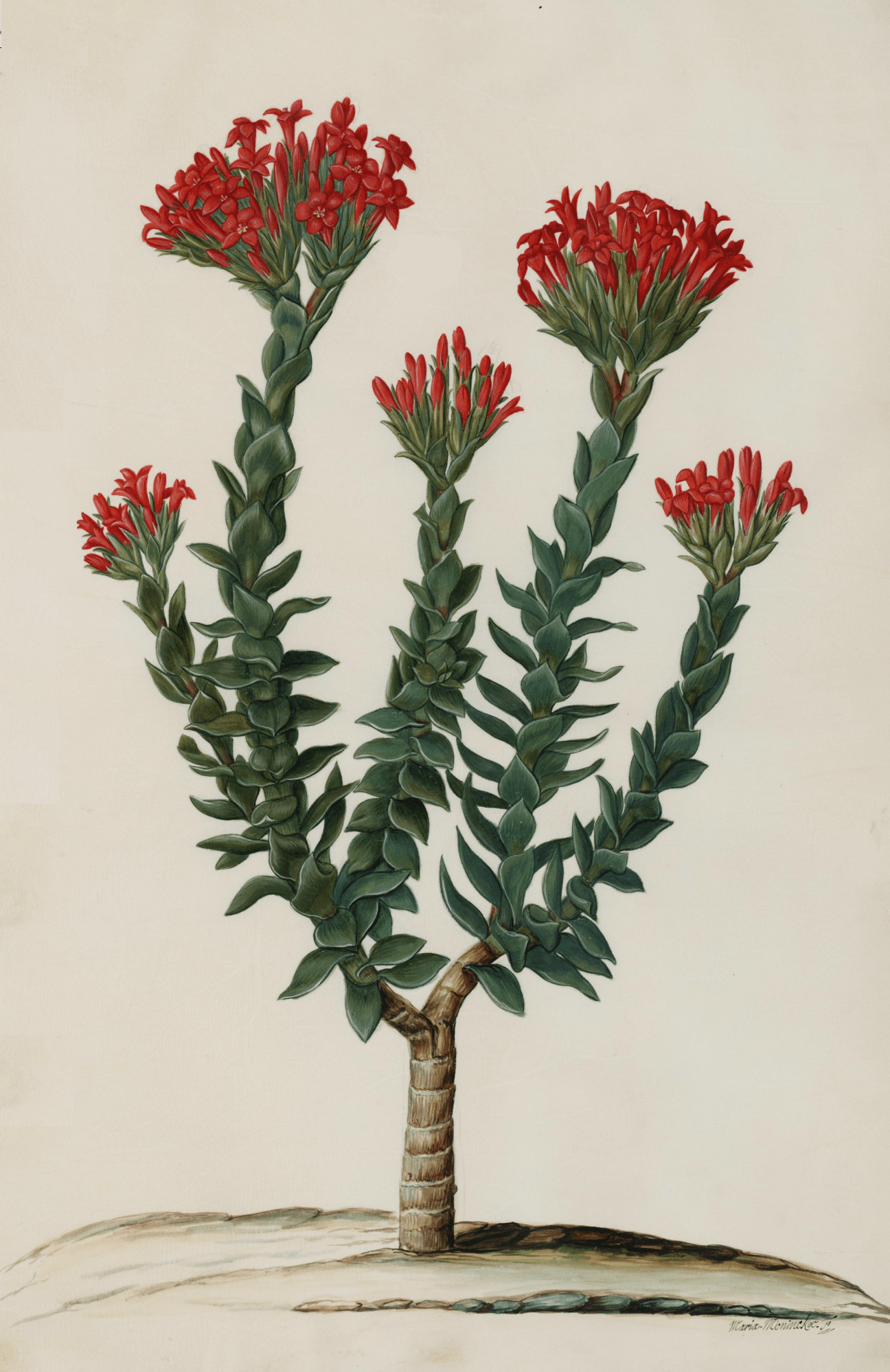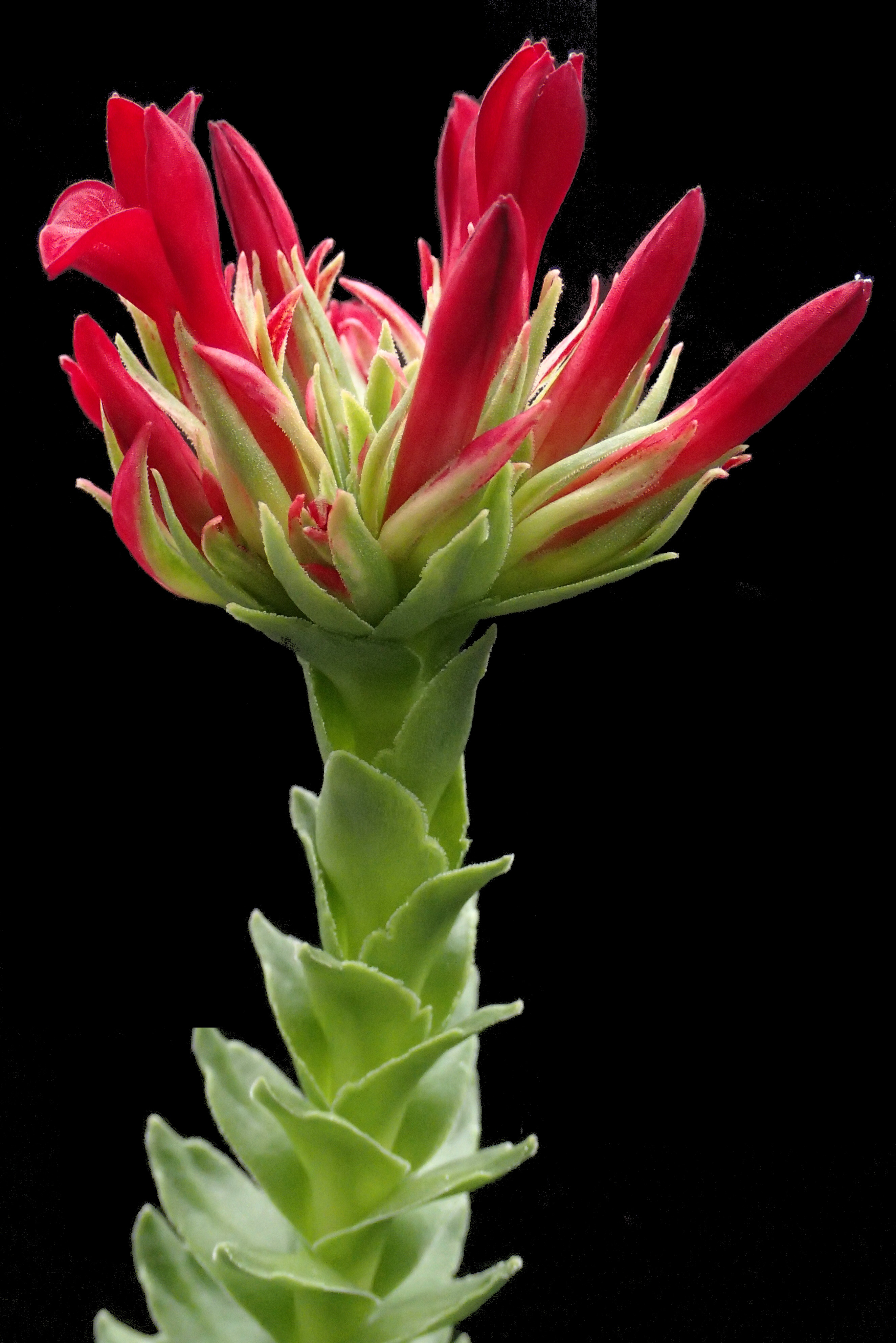Guest column by Theo Heijnsdijk
“The most magnificent and beautiful of all the Crassulaceae is the scarlet Rochea coccinea. Emerging from crevices or growing freely on the flat rocks, the large perennials accommodate their root system in a layer of soil only a few centimeters thick, which sits so loosely on the rock that it can be lifted off together with the plant. The fact that despite its fleshy leaves it is dependent on the moisture coming from the summer clouds is best demonstrated by the cultivation experiment in Cape Town: it only thrives there, even moved to similar locations, if it is watered at least once in a while in summer.”
This is a quote from the book ‘Das Kapland’ by Rudolf Marloth, published in 1908.
According to literature, C. coccinea grows at altitudes over 800 meters in the Southwest Cape. As distribution area, the Cape Peninsula (especially Table Mountain near Cape Town) and the area between Paarl and Bredasdorp (135 km to the southeast) are mentioned.
In reality the area is considerably larger, as evidenced by the photo taken by Bertus Spee in mid-November 2008 in Citrusdal, 125 km north of Paarl. This was at the beginning of the flowering period. In nature it is part of the so-called Fynbos vegetation.

Fig. 1 C. coccinea and an Adromischus in 2008 at the beginning of the flowering period (mid-November) in Citrusdal (Western Cape). Photo Bertus Spee.
The stems become about 40 cm high and they branch from the base. In older plants, the stems become bare and brown from below, with only the tips bearing leaves. Flowering occurs in summer (in Europe in winter). Due to the long flower tube of about 4 cm, only butterflies can access the nectar. Back in 1925 Marloth noted that the butterfly Meneris (now Aeropetes) tulbaghia is the main pollinator. This butterfly is called “the table mountain beauty” or “the mountain pride butterfly” in South Africa and is specialized in red flowers. It is rumoured that you will be chased by the butterfly if you wear a red cap. It is probably the only pollinator for at least 15 plant species in fynbos. Among those 15 are 3 species of the genus Cyrtanthus, which is also known to succulent lovers, and 7 of Gladiolus.
History
Like Kumara (Aloe) plicatilis , discussed in an earlier post, Crassula coccinea belongs to the succulents that were in cultivation in the Netherlands as early as the late seventeenth century. It is first mentioned in a book from 1706 by Caspar Commelin about rare plants in the Hortus Medicus, the predecessor of the current Hortus Botanicus in Amsterdam. The ‘name’ that Commelin gave was ‘Cotyledon Africana frutescens flore umbellato Coccineo’ which means something like: bushy growing African Cotyledon with scarlet flowers in a flat-topped inflorescence.
The accompanying black-and-white drawing shows a plant with flower buds about to open.

Fig. 2 Image of Crassula coccinea in Casper Commelin’s 1706 book.
In the Moninckx atlas (see also the earlier post about Kumara plicatilis) there is also a beautiful colour image. According to the University of Amsterdam, this was made somewhere between 1686 and 1706 by Maria Moninckx. Although the images clearly differ from each other, they both seem to show the same specimen.

Fig . 3 Watercolour of Crassula coccinea by Maria Moninckx (made between 1686 and 1706).
The image in the book ‘Phytanthoza iconographia’ by Johann Wilhelm Weinman from 1737 is also beautiful. Here C. coccinea is depicted together with C. perfoliata and C. tetragona. The funny thing is that a mistake was made with the Latin specific name. It says “fructescens” (bearing fruit) instead of “frutescens” (shrub-forming). Not just a clerical error, because in the German text the plant is called “Fruchtbringend”.

Fig. 4 Image of Crassula coccinea (a), C. perfoliata (b) and C. tetragona (c), in Phytanthoza iconographia from 1739.
Nomenclature
As far as I can tell, the name Crassula first appeared in 1732. The German botanist Johann Jakob Dillenius used it for eight succulents in his work ‘Hortus Elthamensis’. The name means something like ‘fat one’. The common name is ‘thick leaf’. Linnaeus adopted the genus name in his ‘Genera Plantarum’ in 1735 and in 1753 he already described 10 species of Crassula in his ‘Species Plantarum’ (first edition). It’s curious that he mentions Ethiopia as the place of origin for Crassula coccinea, as well as for 7 other Crassulas. Of the 2 remaining ones, C. alternifolia is only given a question mark and in the case of C. scabra, he mentions “Habitat in Africa?”.
Later on, C. coccinea was placed in the genus Rochea. A.P. de Candolle created this genus in 1802 to accommodate the Crassulas with large tubular flowers. The genus name refers to the Swiss botanist Daniel de la Roche. In 1805 the South African mycologist Christiaan Hendrik Persoon changed the genus name to Larochea, after which the Austrian Leopold Trattinnick (botanist and also mycologist) changed it into Dietrichia in 1812. Adrian Haworth in his turn created the genus Kalosanthes in 1821 to accommodate 8 Crassulas including C. coccinea.
He also reported a white-flowered variety (“floribus albis”) based on a book with drawings and descriptions of succulent plants by Richard Bradley from 1716. Unfortunately, a number of drawings in that book were incorrectly numbered and that resulted in, among other things, C. coccinea containing the text of C. tetragona. And there was talk of “small white flowers”. One wonders how well Haworth looked at his sources, as C. coccinea has the largest flowers of the entire Crassula genus.
All the above genus names have been declared invalid and it is again just Crassula. Kalosanthes has remained as the name for one of the 20 sections within the genus Crassula. This section contains only 3 of the over 200 Crassula species. Apart from C. coccinea they are C. fascicularis (= C. odoratissima) and C. obtusa (= C. jasminea). See also fig. 5, where the species of the section are depicted.

Fig. 5 In addition to Tylecodon reticulatus, the 3 Crassulas from the current Kalosanthes section are also pictured. Way back in 1912 Marloth indicated that C. coccinea for its pollination depends on the butterfly Menera (Aeropetes) tulbaghia.
Characteristic of the plants in this section are the long tubular flowers which flare out saucer-shaped at the end. This shape is caused by the fact that the 5 petals are fused over at least half their length and have a widened end at right angles.
In South Africa, C. coccinea is called ‘klipblom’ (stone flower). Also common is the name “Red Crassula” and in older literature one may come across the name ’emperor’s crown’.
Cultivation
C. coccinea was once a widely cultivated indoor plant. In Victorian times, the plant was loved in England for its large bright red flowers and it is one of the few succulents that has been grown commercially on a large scale . The other 2 crassulas from the Kalosanthes section were also widely grown in England at that time. C. obtusa under the name Rochea jasminea -referring to the jasmine-like white flowers and C. fascicularis under the name Rochea odoratissima because of the strong scent.
In Germany too people were involved in growing and breeding this species. Gordon Rowley in his book ‘Crassula, A Grower’s Guide’ mentions that the famous Haage firm in Erfurt offered three cultivars in their 1857 catalogue. In 1868 there were already ten. They have all disappeared from the collections again.
Among the succulent plant lovers we don’t see C. coccinea very much anymore. Young plants are still fresh and compact, but soon they become too tall and untidy. Nevertheless, the species is still grown professionally.
It grows easily and quickly in well-drained soil. Often a mixture of two parts of leaf mould, one part clay and one part sand is recommended. In full sun, a lot of water and fertilizer is required. The plants can be grown from seed or cuttings. Seedlings can already bloom in the first year. The plants are susceptible to the fungal disease ‘rust’ but can’t stand fungicides (pesticides against fungi). After a few years, the plants become ugly with dying leaves at the bottom and deflecting shoots. That is the time to take cuttings. In a mixture of peat and sand they will quickly root.
Cuttings can also just be put in a jar of water. Once they are growing, heading them several times is recommended. This creates compact bushy plants. Supplying a larger pot may also be needed regularly. In summer they can stay outside without problems. In winter keep them cool but do not let them dry out.

Fig. 6 Crassula coccinea flowering in cultivation. The species was massively grown in the 18th century for its large, bright red flowers.
Hybrids
In comparison to some other Crassulas, C. coccinea has not often been used for hybridisation. Probably the oldest hybrid is C. coccinea x falcata. This is midway in appearance between the two species and was named Kalorochea langleyensis. In1898, a specimen was exhibited at the Royal Horticultural Society’s show in Chelsea. This hybrid, which according to the current rules should be called Crassula x langleyensis does not seem to be cultivated anymore.
A hybrid with C. undulata was also once produced, but has suffered the same fate and the same applies to the cross with the white-flowering C. obtusa (Rochea jasminea).
Literature
Arianoutsou-Faraggitaki, M & Groves, R, H. (2012). Plant-animal interactions in Mediterranean-type ecosystems: 137 – 147.
Candolle, A.P. de & Redouté, P.J. (1799-1837): Plantarum Historia Succulentarum, 1: 1.
Commelin, C. (1706). Horti medici amstelædamensis plantæ rariores et exoticæ ad vivum æri incisæ: 24.
Dillenius, J. (1732): Hortus Elthamensis 1: 114 – 121.
Knippels, P.J.M. (1992). The household consumption and turnover of succulents at the flower auctions, Succulenta 71 (1): 33 -38.
Linnaeus, C. (1737). Genera Plantarum: 89.
Linnaeus, C. (1753). Species Plantarum 1: 282 -283.
Marloth, R. (1908). Das Kapland, Wissenschaftliche Ergebnisse der Deutschen Tiefsee-Expedition auf dem Dampfer “VaIdivia” 1898-1899, bd.2, T3:142, 339.
Marloth, R. (1925). The Flora of South-Africa 2: 17 – 24.
Rowley, G. ( 2003): Crassula, A Grower’s Guide.
Weinmann, J.W. (1739) Phytanthoza iconographia 2: 435.
Originally published in Succulenta June 2016. Translated from Dutch by FN.

Fantastic write-up. Thanks for sharing your knowledge.
Many thanks, glad you liked the post.